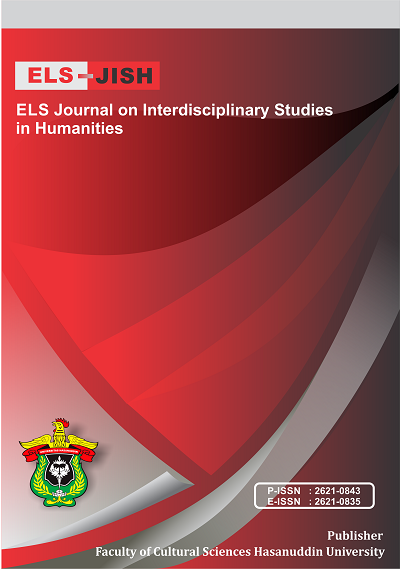Views on the Roles of Non-Native English Speaker Teachers Compared to Their Native Counterparts: Indonesian Context
DOI:
https://doi.org/10.34050/elsjish.v5i3.22353Keywords:
Roles, NNESTs, NESTs, and Indonesian ContextAbstract
The presence of Native English Speaker Teachers (NESTs) in a number of English courses, formal schools and universities has sparked debates among Non-Native English Speaker Teachers (NNSTs) in Indonesia. Some practitioners believe that the involvement of NESTs in education institutions brings about more benefits to their students and institutions than solely hiring NNESTs. However, some others believe that NNESTs are not less superior to their NEST counterparts. This study evaluated these beliefs by looking at the concerns about NNESTs compared to NESTs in the context of Indonesia. The data in this study were obtained from a number of related literatures. Supporting data were obtained through participant observation during the authors’ training in education institutions that involved NESTs and by finding out the views of a university chairman who earned his masters and doctorate degrees in an English Speaking country. Besides, data were collected through an interview with three Australian university graduates who were taught by NNESTs in their secondary (junior and senior high schools) education and trained by NESTs prior to their departure to Australia for pursuing their masters degrees. In the final part, the results of this research indicate that NNESTs still deserve to have the same opportunity as NESTs. The findings, however, also suggest that the contexts in which NESTs and NNESTs are most effective differ.
References
Alseweed, A.M. (2012). University Students’ Perceptions of the Influence of Native and Non-native Teachers. English Language Teaching; Vol. 5, No. 12.
Amalia, S. D. (2016). NNESTs v.s. NESTs: Why Domestic English Teachers Should Not Worry about Their Foreign Counterparts. PROSIDING ICTTE FKIP UNS 2015, 1(1). Retrieved from https://www.google.co.id/url?sa=t&rct=j&q=&esrc=s&source=web&cd=5&cad=rja&uact=8&ved=0ahUKEwjQ66uBxY7SAhWIqY8KHX8uCx4QFgg_MAQ&url=http%3A%2F%2Fjurnal.fkip.uns.ac.id%2Findex.php%2Fictte%2Farticle%2Fdownload%2F7669%2F5510&usg=AFQjCNEZLgrlSKYrU39T6Ezr0p6HZLhs3A&sig2=yTfRnVsi3Nl72FGmchnadQ&bvm=bv.146786187,d.c2I
Arntsen, T. (2014). ESL Controversy: Native Speaker vs. Non-Native Speaker. Retrieved 12 January 2017, from http://busyteacher.org/4570-esl-controversy-native-speaker-vs-non-native.html
Beare, K. (2016). English only? Retrieved 28 January 2017, from http://esl.about.com/od/modernteachingtechniques/a/English-Only.htm
Çakir, H. (2013). A comparative analysis between NESTS and NNESTS based on perceptions of students in preparation classes. The International journal of social sciences, 14(1), 36 - 47.
Creswell, J. W., & Creswell, J. D. (2017). Research design: Qualitative, quantitative, and mixed methods approaches: Sage publications.
Dita, S. (2009). Physical and topical structure analysis of professional writing in inner, outer, and expanding circles of English. TESOL Journal, 1, 95-118.
Oxford University Press. (2014). Is it always preferable to employ only native English speaking teachers? Retrieved 10 February, 2017, from https://oupeltglobalblog.com/2014/10/14/is-it-always-preferable-to-employ-only-native-english-speaking-teachers/
Ezberci, E. (2005). Native English speaking teachers and non-native English speaking teachers in Istanbul: a perception Analysis. (Master of Arts), Bilkent University, Ankara.
Gurkan, S., & Yuksel, D. (2012). Evaluating the contributions of native and non-native teachers to an English Language Teaching program. Retrieved from: http://akademikpersonel.kocaeli.edu.tr/dogan.yuksel/diger/dogan.yuksel02.05.2013_08.11.35diger.pdf
Hoffman, S. (2016). How different is to learn English from non-native English speaking local teachers vs. native English speaking teachers, for children? Retrieved 12 January 2017, from https://www.quora.com/How-different-is-to-learn-English-from-non-native-English-speaking-local-teachers-vs-native-English-speaking-teachers-for-children
IDP Education. (2022). Beasiswa Kuliah ke Luar Negeri: Temukan dan daftarkan diri Anda ke berbagai beasiswa internasional yang tersedia bagi pelajar Indonesia. Retrieved on 23 August 2022 from https://www.idp.com/indonesia/study-abroad/scholarships/
Jazadi, I. (2008). The Politics of Curriculum: An interpretive study of English language teaching and learning at high schools in Indonesia. Sumbawa: Paracendekia NW Press.
Maum, R. (2002). Nonnative-English-Speaking Teachers In The English Teaching Profession. Jcps Adult And Continuing Education Edo-Fl- Eric Digest.
Medgyes, P. (2006). When the Teacher is a Non-Native Speaker. In M. CelceMurcia (Ed.), Teaching English as a Second or Foreign Language (pp. 429-442). Beijing: Foreign Language Teaching and Research Press.
Merino, I. G. (1997). Native English-Speaking teachers versus Non-native English-Speaking teachers. Revista Alicantina de Estudios Ingles, 10, 69-79. Retrieved from https://rua.ua.es/dspace/bitstream/10045/5996/1/RAEI_10_07.pdf?utm_source=volunteerforever.com&utm_medium=referral&utm_campaign=vf-teach-english-abroad-volunteer-programs-for-education-abroad
Miles, B. M. & Huberman, A. M. (1994). Qualitative Data Analysis (2nd ed.). SAGE Publication: UK.
Moleong Lexy, J. (2004). Metode Kualitatif [Qualitative Methods]. Remaja Rosdakarya, Bandung.
Mu’in, F. (2019). Sociolinguistics: A language study in sociolinguistics perspectives. Jurusan Pendidikan Bahasa dan Seni, Fakultas Keguruan dan Ilmu Pendidikan, Universitas Lambung Mangkurat, Banjarmasin.
Novianti, A. (2018). Native versus non-native English speaking teachers: An insight into Indonesian students’ voices. Jurnal Pendidikan Bahasa dan Sastra, 18(1), 44-57.
Pratiwi, W. R., Atmowardoyo, H., & Salija, K. (2020). The Need Analysis of Participation in an English Immersion Village at" Kampung Inggris Pare". International Journal of Language Education, 4(1), 158-170.
Rizky, D.D. (2013). Students’ perspectives on being taught by Native English Speakers: A case study at a private local English community. A Thesis of Universitas Jambi.
Sari, M. (2018). Improving students’ vocabulary mastery through Text Project for the seventh grade students of MTs. Al-Majidiyah NW Sumbawa in the school year 2017/2018. Unpublished bachelor thesis. STKIP Paracendekia NW Sumbawa.
Solihin. (2012). The role of encounter project on students’ motivation to speak English: a case study of the sixth semester classroom setting of STKIP Hamzanwadi Selong in the academic year 2011/2012 (Unpublished Bachelor's thesis). STKIP Hamzanwadi Selong.
Suharjati, F. (2015). History of teaching English as a foreign language in Indonesia. Deiksis, 2(03), 161-168.
Sugiyono. (2010). Metode penelitian kuantitatif, kualitative dan R & D [Methods for Quantitative, Qualitative, R & D]. Bandung: Alfabeta.
Tajeddin, Z., & Pakzadian, M. (2020). Representation of inner, outer and expanding circle varieties and cultures in global ELT textbooks. Asian-Pacific Journal of Second and Foreign Language Education, 5(1), 1-15.
Tanu, D. (2010). Negotiating the global in a local setting: Exploring cultural hierarchies in international schools in Indonesia. In 18th Biennial Conference of the Asian Studies Association of Australia, Adelaide.
Walkinshaw, I. (2012). Native- and Non-Native Speaking English Teachers in Vietnam: Weighing the Benefits. The Electronic Journal for English as a Second Language, 16(3). Retrieved from http://www.tesl-ej.org/wordpress/issues/volume16/ej63/ej63a1/
Xiaoqiong, B. H., & Xianxing, J. (2011). Kachru’s three concentric circles and English teaching fallacies in EFL and ESL contexts. Changing English, 18(2), 219-228.
Downloads
Published
Issue
Section
License
Copyright (c) 2022 Solihin, Aris Dwi Intan Aprianti

This work is licensed under a Creative Commons Attribution-NonCommercial-ShareAlike 4.0 International License.






